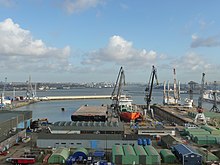Keppel Verolme
Keppel Verolme BV is a shipyard in Rotterdam that specializes in the conversion and repair of large ships, drilling rigs, pipelayers and floating cranes. The company belongs to the Keppel Corporation from Singapore. In 2017 it was taken over by the Damen Shipyards Group and has been called Damen Verolme Rotterdam since then .
Founded in 1957
The shipyard was founded on June 27, 1957 in the new port and industrial area of Botlek as Verolme Dok en Scheepsbouw Maatschappij (VDSM). Located near the sea on the sea-deep water of the Nieuwe Waterweg (New Waterway), there were no problems with the draft of large ships. In addition to a dry dock , helges and floating docks were set up for the construction and repair of super tankers and large bulk carriers . When Verolme Dok en Scheepsbouw Maatschappij was officially opened on June 27, 1957, it was one of the largest and most modern shipyards in Europe. The following year, on August 10, 1958, the Verolme Verenigde Scheepswerven (VVSW) shipyard group was formed through the merger with three other shipyards of the Dutch shipbuilding magnate Cornelis Verolme .
In 1970 a huge dry dock with dimensions of 405 × 90 meters was built, it was the largest dry dock in Europe at the time and could accommodate ships of up to 500,000 dwt. The Esso Cambria (255,000 dwt), a large tanker, was the largest ship built in the Netherlands in 1970. It was surpassed by the Lepton in 1974 with 318,000 dwt.
In response to government pressure, the financially troubled parent company Verolme Verenigde Scheepswerven joined the Rijn-Schelde Machinefabrieken en Scheepswerven (RSMS) group on January 1, 1971 , which then traded as Rijn-Schelde-Verolme Machinefabrieken en Scheepswerven (RSV).
Verolme Botlek BV
In 1981 the huge slipway on Nieuwen Waterweg was closed, the construction of the new ship ended and the shipyard concentrated on the repair and conversion of ships and offshore platforms. A good example is the crane half-diver Balder . Originally designed as semi-submersible crane vessel constructed (SSCV, semi-Submersile Crane Vessel) of Mitsui and built, it was of Verolme Botlek in a deep-working ship with additional Propulsionseinrichtungen for dynamic positioning rebuilt (DP-system of the class III).
After the Rijn-Schelde-Verolme Machinefabrieken en Scheepswerven went bankrupt on April 6, 1983, the bankrupt group was unbundled and some viable shipyards continued, including Verolme Botlek.
Keppel Verolme BV
After further turbulence in the 1980s, Verolme Botlek was taken over by the Singapore shipbuilding company Keppel Corporation and in 2002 changed its name to Keppel Verolme BV. Today the focus of the shipyard is on the repair, overhaul and conversion of large ships and floating offshore systems, such as large floating cranes and drilling rigs. The Saipem 7000 was also rebuilt in this shipyard in the winter months of 1999 and 2000, while the diesel-electric power supply was strengthened and a new system for dynamic positioning (DPS) and additional facilities for pipeline laying were installed. For the first time in its 20-year service life, the Saipem 7000 was dried out from December 2007 to March 2008 in the dry dock of this shipyard for work on the underwater hulls, the thrusters, the propeller pods and the valves of the ballast system.
Web links
literature
- STG yearbooks
Coordinates: 51 ° 53 ′ 30 ″ N , 4 ° 17 ′ 25 ″ E


